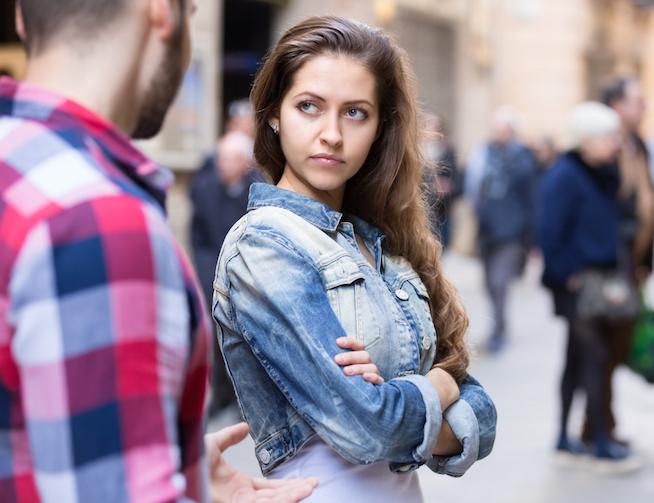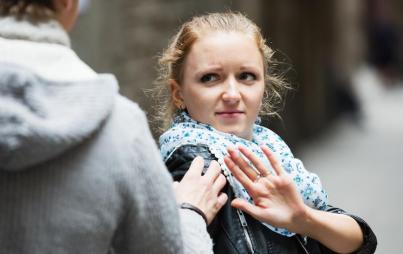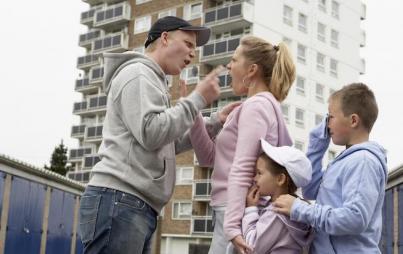
Street harassment is a global problem. Wherever you go, marginalized people have to deal with verbal abuse, harassment, and violence simply for entering public space. Holly Kearl, founder of Stop Street Harassment and International Anti-Street Harassment Week, has published her third book — this one looking at street harassment on an international scale. It’s aptly titled Stop Global Street Harassment: Growing Activism Around The World. After reading her book, I decided to have a chat with grassroots street harassment activists from around the globe and find out a little more about what street harassment is like in their communities — and what they’re doing to fight it. Obviously, this is just a small sampling of the work being done and the people being affected by street harassment, but it’s clear that the issue crosses racial, ethnic, and cultural lines and is a universal experience for marginalized folks around the world.
Can you tell me a little bit about your work?
Sarah Fick, People’s Justice League, Southeast, OH, United States: We feel passionate about working on street harassment, because it's one of the most common forms of violence against women, and it's a behavior that contributes to rape culture.
Agnieszka Biela, Hollaback! Polska, Poland: One day I found out that one of the biggest and most popular websites in Poland promoted the film presenting sexual harassment of woman as "fun" on their main page. I contacted Hollaback Poland team and proposed an action against the website. They asked me to join them and so on January 2013 I started working at Hollaback! Poland as a volunteer.
rebel.lieus, Belgium: We found street harassment has a limited connotation as it is mostly understood as sexual street harassment towards heterosexual, white, young, able-[bodie]d women. Therefore we wanted to talk about harassment in public spaces, rather than street harassment. Also public spaces should be understood more broadly than the streets, such as schools, public transport, pubs, etc. rebel.lieus is still in starting phase, bringing together team members from Brussels and Ghent, hoping to address public harassment in Belgium. rebel.lieus works trilingual: Dutch (official language in Belgium, ‘rebellieus’ is dialect for rebellious), French (official language in Belgium, ‘lieus’ refers to spaces) and English (could be read as rebellious). We are a team of 7 (6 women, 1 man), and knowing that we ourselves are not a diverse group, we want to mostly listen and learn the coming year.
Jodie Layne, Safer Spaces Winnipeg, Winnipeg, Manitoba, Canada: The current work I do started out of a conversation about rape culture in the music scene here.
Jess Lee, ClevelandCAN, Cleveland, OH, United States: I’m an activist for issues surrounding survivor, black + femme, queer, and racial identities and a member of Cleveland Community Activist Network (ClevelandCAN). Cleveland CAN exists to empower Black Women (cis and trans) to lead while also serving as a resource for community activist groups in order to create cohesive, sustainable, and successful social justice movements in the Greater Cleveland Area. ClevelandCAN was formed early 2015 in the wake of the murders of Tanisha Anderson and Tamir Rice in response to the need for more black and brown female activist leadership in the Cleveland Community. It also serves as an online platform for the community to submit and share events.
Gabriela Duhart, CoHabita, Mexico City, Mexico: CoHabita came to be after my collaboration with Habitajes AC, an organization that focuses on issues in public space and addresses them through art. It means "itinerant communities against street harassment." We worked with Tatyana Fazlalizadeh [of Stop Telling Women To Smile] during her visit to Mexico.
Rochelle Keyhan, Feminist Public Works, Philadelphia, PA, United States: We are a non-profit that focuses on gender-based safety in public spaces, of which street harassment is only a part.
How would you describe the problem of street harassment where you live?
Southeast OH, US: Thanks so much for asking this question. So far it seems that the conversation around street harassment has been focused around urban areas, and folks often site things about population density, saying you're more likely to be harassed in densely populated areas, but street harassment is still a serious issue in rural areas as well. Appalachian Ohio is a sparsely populated area with high poverty rates and a couple of colleges thrown into the mix. It has been difficult to find other folks from rural areas working on street harassment, and we've been thinking a lot about how street harassment is similar and how it's different for us here in rural Appalachia. To me, the behavior looks pretty similar, but the biggest difference is that here, even walking down main street, it could quite easily be just you and the harasser, and with no witnesses, the fear factor is much higher. This thing could escalate, and no one would even know. Also, as someone who has lived in poverty all my life, I've been street harassed in a classist way just as much as I've been street harassed in a sexualizing way.
Poland: It is quite common problem, yet not recognised properly both by the women and men. Usually, men don't believe the problem exists at all and many women have it so normalized that they need very safe atmosphere of conversation to admit they find it uncomfortable or even frightening. We were the first organisation to introduce the term "street harassment" in Poland and many people who are familiar with the topic of gender-based violence started using this. However, even amongst feminist activist there aren't many people in Poland who fully understands the complexity of this problem (ex. the connection with other forms of gender-biased violence, homophobia, transphobia, xenophobia, etc.). There is no recognition of it in the law nor is it seriously treated by media.
Belgium: Street harassment covers a whole range of very different experiences for different groups and persons. The problem is that these are mostly not recognized as street harassment. On a daily basis, harassment is experienced not only on base of gender, but also based on sexuality, ethnicity [note: in Europe we don’t use ‘race’ (‘ras’ in Dutch), there is only the human race and talking about races is very much linked to the biological, racist thinking. We mostly talk about ethnicities but still it is an ongoing debate on how persons who are racialized are called.], ability, citizen status, religion . . . And most often, acts of harassment need to be understood from the point of intersectional identities. So, we not only talk about sexual harassment, but also racism, police violence, policies pushing marginalized groups to the outskirts of communities (ex. prostitutes), restrictive rules for entering public spaces (ex. prohibition of wearing a head scarf or even long skirts in schools).
Winnipeg, Manitoba, Canada: Rampant, ubiquitous, and highly racialized in nature. It's definitely experienced more by people of colour here, but Indigenous women experience and exorbitant amount of harassment.
Cleveland, OH, US: It’s a major issue for black women, women of color, trans folk, and members of the LGBT community. Many Clevelanders rely on public transport, and if you are a marginalized group, in public people assume a right to speak to you (or AT you), to come into your space, to question your right to access certain public spaces, or even to follow you. Segregation and economic disparity in Cleveland also play into the dynamics of street harassment. Trans folk and people of color often talk about being singled out, facing harassment in certain neighborhoods, and sometimes even being followed by the police.
Mexico City, Mexico: It varies in style but it is rampant and non-discerning of age, class, or race. There are local government policies in place such as women-only busses, denouncing stations, etc. But street harassment is a very common part of people's lives in Mexico City. Particularly women and LGBT folks. This severely limits our access and performance in private and public space and the right of free transit.
Philadelphia, PA, US: We have all types of harassment: on sidewalks, at transit stops, from people in cars. We have harassment and groping on transit stops and public sidewalks and crowded places. The harassment ranges from menacing stares, to following in public spaces, to "hey sexy/hey baby," to vulgar sexual comments or physically threatening comments.
What are the biggest challenges for you in combating street harassment in your community?
Southeast OH, US: I'd say just how pervasive it is and how little people have been confronted with the idea that it's not OK. The town that I live in has a population of less than 400 people. There, the conversation around street harassment is nil. I've been sexually harassed by boys as young as 5 years old, and the adult woman who was accompanying him did nothing. They learn these things young and are not told by their guiding adults that it's not okay. Then when I go around telling people it's not OK, I'm assumed to be a crazy, man-hating liberal whose trampling on men's rights and free expression and who's unable to take a compliment. But since 2012, we've made the conversation more visible among longer-term residents and collected allies who are standing up for themselves and others.
Poland: Polish community is still very conservative which makes the conversation on street harassment quite hard — as the part of the traditional role of women and men, street harassment is often recognised as a compliment, a normal and acceptable interaction between men and woman. Saying it is not compliment but potentially harmful behavior is generally recognised as the end of "normal relations" between women and men. We also have a problem with the Polish equivalent of [the term] "street harassment." There is no way to translate the term accurately to Polish. The Polish translation we use, which is "molestowanie w przestrzeni publicznej," is strongly associated with sexual assault so many people don't recognise certain behavior as street harassment if it doesn't connect with explicit sexual context (like touching or groping).
Belgium: We want to take all different experiences into account and let them come together to find inclusive and efficient solutions. We feel that now the most marginalized groups in our country, communities are left to their own. This is also linked to existing stereotypes about these groups and street harassment.
Winnipeg, Manitoba, Canada: Bureaucratic red tape. There seems to be will of people and of policy-makers and lots of good intentions, but I couldn't stand another committee meeting where things moved at a snail's pace. I feel more effective in the community than in a meeting talking about community. Also, the ever-present problem of how to actually connect with people who harass in an attempt to educate and have a conversation instead of taking punitive measures.
Cleveland, OH, US: There are limited platforms for people to speak about their experiences, or for folks to see street harassment as an issue beyond the idea of gender-based violence.
Mexico City, Mexico: Street harassment is still an issue that a lot of people do not want to talk about. We live in communities that are unveiling a deep hatred of women, and with the alarming rates of demo code of our sisters, street harassment depicts a lot. Which is terrifying. The main issues lie in the unbalanced power dynamics that are deeply embedded in our culture and regarded as normal.
Philadelphia, PA, US: Resources. We don't have the capacity to have as many workshops and public conversations and regular, large scale programming as we would like.
What kinds of stereotypes about street harassment do you find are most prevalent/are you working hard to combat in your area?
Southeast, OH, US: I hear college-aged white women who aren't from here mention construction workers a lot, which I feel can be classist. I don't want to discredit anyone's personal experiences, but I wonder how much of it comes from their actual experiences and how much is cultural expectation.
Poland: There is the stereotype that whether a woman recognises the behaviour as street harassment depends on the physical attractiveness of the harasser. For some time we also have to face Islamophobic stereotypes — people tend to say that street harassment is something "those Islamist do to women" and the problem doesn't exist in Poland as a "developed and democratic country."
Belgium: (1) The stereotype of young men of colour perpetrating street harassment in specific (city) neighborhoods. It is seen as part of a foreign culture, “something that would otherwise not happen here.” It is a harmful recuperation of feminist language to sustain racism, which we want to fight. (2) Street harassment is seen as a petty issue (“it is just compliments you should deal with,” it is only perceived as whistling or calling names, which is not seen as harmful) and talking about it stands in the way of dealing with the real, bigger issues (often also linked to an imperialist idea of “women in other parts of the world are far worse off”). (3) Mostly street harassment is understood as sexual comments towards heterosexual, white, abled, young women.
Winnipeg, Manitoba, Canada: It's not as much a stereotype, but a derailment: always seem to get questions about "aggressive" panhandlers and "what about the men?!"
Cleveland, OH, US: When people think of street harassment they think of it as (1) relatively harmless and (2) something that happens to white cis women. The images of street harassment + police brutality, street harassment + transmisogyny (transmisogynynoir), street harassment + black and brown women don't exist, and when they do, they don't depict the violence that these groups are experiencing.
Mexico City, Mexico: There is a lot of slut-shaming and the assumption that women ask for it. Moreover, the idea that it is normal is very common. And [we’re trying to challenge] the preconceptions of how men/women should behave. About what it should mean to be a woman and a man in public space. That is very dangerous.
Philadelphia, PA, US: We used to get a lot of dismissal about it being a compliment, or about us having thin skin and needing to toughen up. People also regularly commented that it hardly ever happens. But after five years of activism we don't experience as much in the way of stereotypes. We still of course have street harassment, but culturally, Philly seems to understand it as a problem that exists. Maybe the stereotype we're dealing with now is overcoming the acceptance of street harassment as inevitable/unavoidable.
What kinds of solutions does your work focus on?
Southeast OH, US: We focus on education and community accountability. We've created a new platform on which folks can continue to do collective online storytelling. It's based in Amani, which is the same platform that runs Harassmap in Egypt. Harassmap and the street artists of Egypt have been huge sources of inspiration for me personally, and we've found the storytelling aspect to be a valuable tool. It's awareness raising, but also, we don't just let the stories sit there. We look for patterns and use the info to direct programming. For instance, a lot of our stories are centered around Court Street, which has a high density of bars, so we launched a Safer Spaces Campaign, where we train bartenders and other service staff in bystander intervention, and they take a pledge saying they will intervene and take complaints from customers and co-workers seriously. We then advertise participating business on our webpage, so folks can feel a little safer going out, like someone will have their back if they are handling a situation and feel they need to call in backup. Also recently, our webpage has become an anonymous call out page where folks have been calling out serial predators that live in the area who have never been convicted. To me, it's a good step toward community accountability to make the entire community explicitly aware of person who has been a problem for a long time and has not made any movements toward owning up to it or making changes.
Poland: We're working on highlighting the problem in our community — strengthening the voice of women who speak out about street harassment and other forms of gender-based violence. We also consequently react to public statements (from politicians, media, etc.) promoting rape culture, organising our community in protest to spread awareness on the topic and build the sense of community amongst women. We also work to highlight gender stereotypes in media and advertisement.
Belgium: We want to bring together marginalized experiences and enhance voices. Therefore we want to work together with other organizations as to avoid working in separate (limited in knowledge and experience) siloes.
Winnipeg, Manitoba, Canada: Right now almost all of the work of Safer Spaces Winnipeg is focused on making bars and other spaces in the music communities more safe by working with venues and festivals.
Cleveland, OH, US: It’s a huge issue to focus on, currently our work is internal. Learning, reading,and following the work of black, trans, and queer activists who are speaking out about the issue. Then sharing their example through our online platforms. [People need to not] leave black, queer, and trans women behind as they look for solutions. Street harassment is more than uplifting the tradition of making the streets safe for white women. Street harassment is about the epidemic of black trans women and trans women of color being murdered. Street harassment is also about state violence, and the police NOT being the safest option for some people experiencing this type of public violence and we must remember that when we craft solutions.
Mexico City, Mexico: Healing workshops, reappropriation of public space. Creation of networks and safe spaces.
Philadelphia, PA, US: Our focus has been at the definitional stage: Encouraging people to talk to each other about harassment, at home, at school, at work, after harassment happens, etc. call out the behavior and have conversations about it. Essentially the focus is to name the behavior and call it a problem. We are currently in the engagement stage where others are organizing around the issue, having larger scale conversations and we are helping to support that work. Our long term goal is for the cultural shift at a policy level.
What work is your organization currently doing that you're most excited about?
Southeast OH, US: I'm excited about our work at Trimble High School. We've developed a set of lessons to deliver to their freshman health class that covers street harassment, bystander intervention, healthy masculinity, and women's self-defense. I also run a women's circle at the regional jail. The majority of the women are there because of addiction, whether its possession or drug related theft. Since we know that about 78% of addicts are struggling with childhood trauma, we'd like to work toward teaching kids healthier coping mechanisms to deal with things like street harassment and sexual assault, in hopes that they might not need to rely on the drugs that seem so readily available out there.
Poland: The thing that I am personally most excited about now is WenDo Training Academy I am learning at. WenDo is the method of assertivity and self-defence for women based on empowerment model. It is available for all the persons socialized to the role of woman, also including people with disabilities. It presents intersectional approach and gives a lot of opportunities for networking with other activists. I am planning to teach woman WenDo in the future, empowering them so that they would know what to do when they face discrimination and gender based violence, including street harassment.
Belgium: We are working towards a workshop with refugee children in Brussel that will take place this fall. We aim to work creatively with them about their experiences of public spaces, how they feel in them in Belgium, and what they would like to see happen to feel better in them. Possibly a workshop with refugee adults could follow. When talking about harassment in public spaces their perspective and experiences are almost never heard!
Winnipeg, Manitoba, Canada: Learning and having discussions. We slowed down/temporarily our community-based harassment initiatives because we realized they weren't necessarily meeting the needs of the community. After starting anew as an organization, I think it's so important to make all of our new programming relevant and collaborative with a community-led approach. How can we be more supportive of work that's already happening and that's been happening? That's exciting to me. I'd rather we come back slow then come back wrong.
Cleveland, OH, US: ClevelandCAN recently presented a workshop on combating Femmephobia at the 2015 Movement for Black Lives. We will also be in attendance at FemmeFest 2105 in Columbus, Ohio. We're open to other opportunities to speak about not only street harassment, but community activism, and recognizing the leadership of black trans women and black and brown cis women.
Mexico City, Mexico: We won a project from the federal government in Mexico for workshops and street art interventions regarding street harassment. This is going on currently and the experience has been wonderful in the creation of a network of women who speak out and support each other around the issue of sexual violence in public spaces.
Philadelphia, PA, US: The work we’ve been doing through our Geeks For CONsent project to tackle harassment at conventions. I am running the programs on my own right now so we don't have any specific projects pending at the moment.
Describe your anti-street harassment work in one sentence.
Southeast OH, US: We believe that public space should be safe and accessible to everyone and work to engage the community toward creating safer streets, campuses, establishments, and gathering places in Southeast Ohio.
Poland: Empowering women and strengthening their voice to fight street harassment.
Belgium: Broadening our scope of harassment in public spaces to make our work more inclusive, more human, and more efficient.
Winnipeg, Manitoba, Canada: Safer Spaces Winnipeg's work is a work in progress that aims to be of service to the community in relevant ways.
Cleveland, OH, US: Unapologetically black, femme, queer, militant, and intersectional.
Mexico City, Mexico: Itinerant communities against street harassment through street art and creation of collective memory.
Philadelphia, PA, US: We focus on ending gender-based harassment in public spaces through community and civic engagement.





